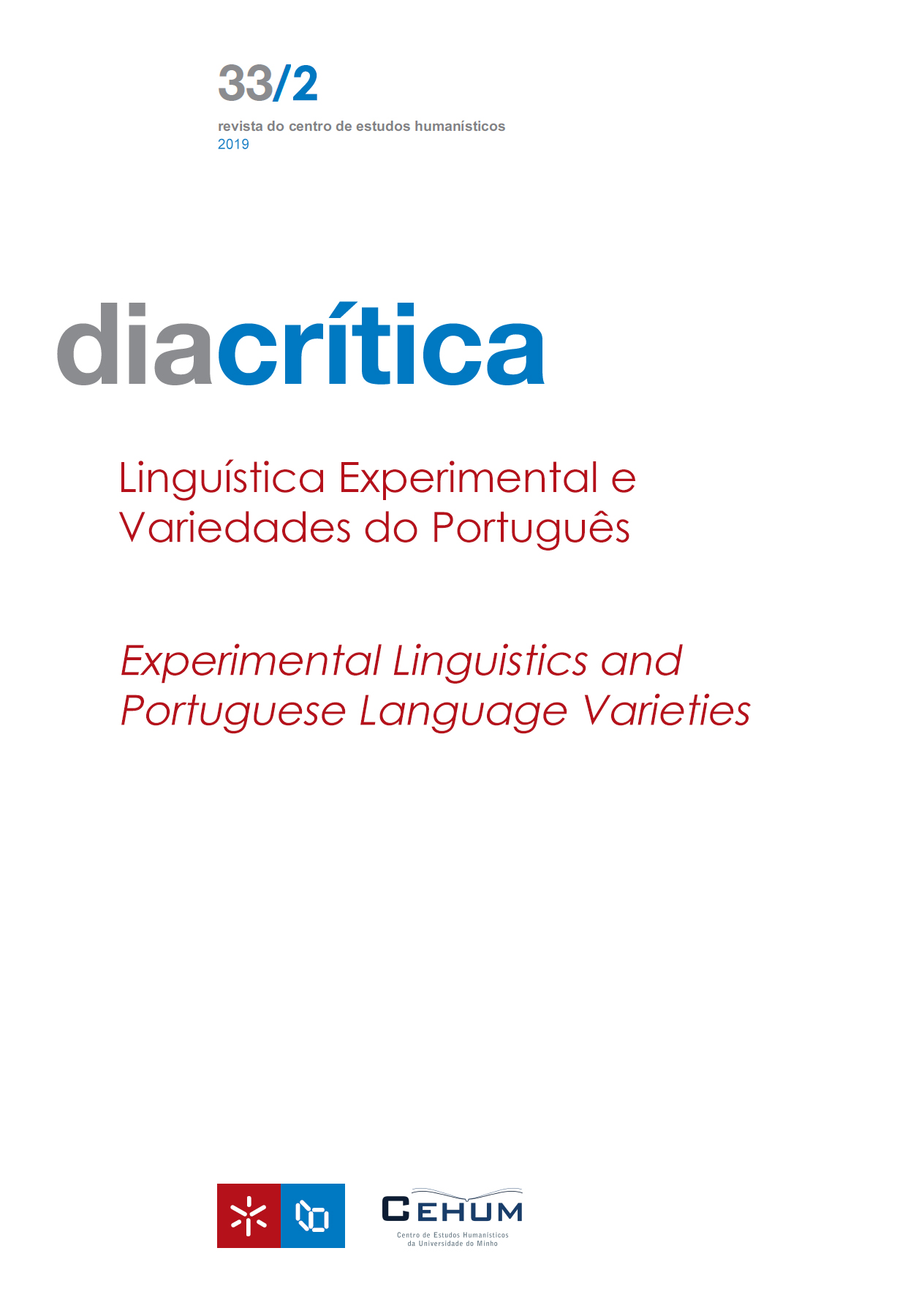O singular nu no inglês e no português brasileiro: abordagens experimentais sobre atomicidade
DOI:
https://doi.org/10.21814/diacritica.5059Palavras-chave:
Comparação, Distinção contável-massivo, Português brasileiro, Singular nuResumo
A partir de uma discussão sobre o papel da atomicidade no domínio da distinção contável-massivo, propomos uma análise para o Singular Nu (SNU) tanto no inglês quanto no português brasileiro (PB). Nosso objetivo é verificar experimentalmente o caráter atômico (ou não) desses sintagmas. Para tanto, analisamos dados de um teste realizado por Scontras, Davidson, Deal e Murray (2017), que mostram que o SNU no inglês enseja principalmente leitura de volume em comparativas. Segundo nossa análise, essa interpretação é explicada como coerção, o que corrobora a denotação do SNU como um predicado atômico nessa língua. Para o caso do SNU no PB, desenvolvemos um teste de julgamento de quantidade, nos moldes de Scontras et al.(2017), para verificar as dimensões usadas na comparação em sentenças com o plural, o nome massivo e o SNU, em oposição a sentenças sem o nome expresso (Quem tem mais?). Os resultados mostram que sentenças com o SNU possuem os mesmos julgamentos de sentenças sem o nome expresso. Argumentamos, então, que o SNU no PB não carrega qualquer traço gramatical de atomicidade, diferentemente do plural e do nome massivo, que carregam traços [+atom] e [-atom] respetivamente.
Referências
Bale, A.& D. Barner. (2009). The interpretation of functional heads: Using comparatives to explore the mass/count distinction. JournalofSemantics,26,217–252.https://doi.org/ 10.31234/osf.io/ktx59. DOI: https://doi.org/10.1093/jos/ffp003
Barner, D.&Snedeker, J. (2005). Quantity judgments and individuation: Evidence that mass nouns count. Cognition,97(1), 41–66.https://doi.org/10.1016/j.cognition.2004.06.009. DOI: https://doi.org/10.1016/j.cognition.2004.06.009
Beviláqua, K. &Pires de Oliveira, R. (2014). Brazilian bare nouns and referentiality: Evidence from an experiment. RevistaLetras, 90, 235–275. https://doi.org/h10.5380/rel.v90i2.37234. DOI: https://doi.org/10.5380/rel.v90i2.37234
Beviláqua, K.&Pires de Oliveira, R. (2017).Brazilian bare nouns in comparatives: Experimental evidence for non-contextual dependency. RevistaLetras, 96, 354–376.https://doi.org/10.5380/rel.v96i1.51033. DOI: https://doi.org/10.5380/rel.v96i1.51033
Beviláqua, K.&Pires de Oliveira, R. (2018). What do bare nouns mean cross-linguistically? Preliminary results. Artigo apresentado emThe Mass-Count distinction -A linguistic misunderstanding?, 7–9 maio, Bochum, Alemanha. Resumo disponível em http://count-and-mass.org/becl2018/abstracts/AbstractBochumBevilaquaandPiresdeoliveira.pdf
Beviláqua, K., Lima, S. &Pires de Oliveira, R. (2016).Bare nouns in Brazilian Portuguese: An experimental study on grinding. Baltic International Yearbook of Cognition, Logic and Communication, 11, 1–25. https://doi.org/10.4148/1944-3676.1113. DOI: https://doi.org/10.4148/1944-3676.1113
Bloomfield, L. (1933). Language. New York: Henry Holt.
Chierchia, G. (1998). Plurality of mass nouns and the notion of semantic parameter. In S. Rothstein (Ed.), Eventsandgrammar(pp. 53–103). Dordrecht: Kluwer. DOI: https://doi.org/10.1007/978-94-011-3969-4_4
Chierchia, G. (2010). Mass nouns, vagueness, and semantic variation. Synthese, 174, 99–149.https://doi.org/10.1007/s11229-009-9686-6 DOI: https://doi.org/10.1007/s11229-009-9686-6
Chierchia, G. (2014). How universal is the mass/count distinction? Three grammars of counting. In A.Li, A.Simpson &Wei-Tien Dylan Tsai(Eds.), Chinesesyntaxina cross-linguistic perspective (pp. 147–175).https://doi.org/10.1093/acprof:oso/9780199945658.003.0006 DOI: https://doi.org/10.1093/acprof:oso/9780199945658.003.0006
Cresswell, M. J. (1976). The semantics of degree. InB. Partee(Ed.), Montaguegrammar(pp. 261–292). New York: Academic Press. DOI: https://doi.org/10.1016/B978-0-12-545850-4.50015-7
Doetjes J.S. (2017).The count/mass distinction in grammar and cognition. AnnualReviewofLinguistics,3,199–217.https://doi.org/10.1146/annurev-linguistics-011516-034244 DOI: https://doi.org/10.1146/annurev-linguistics-011516-034244
Frisson, S.&Frazier, L. (2005). Carving up word meaning: Portioning and grinding. JournalofMemoryandLanguage, 53(2),277–291.http://doi.org/10.1016/j.jml.2005.03.004 DOI: https://doi.org/10.1016/j.jml.2005.03.004
Jespersen, O. (1924). The philosophy of grammar. London: George Allen &UnwinLtd.
Krifka, M. (1998). The origins of telicity. In S. Rothstein (Ed.),Eventsandgrammar(pp. 197–235).Dordrecht: Kluwer. DOI: https://doi.org/10.1007/978-94-011-3969-4_9
Lima, S. (2014). The grammar of individuation and counting(Tesede doutoramento, University of Massachusetts,Amherst, USA).
Link, G. (1983). The logical analysis of plurals and mass terms: A lattice-theoretical approach. In R. Bauerle, C. Schwarze &A. Stechow(Eds.), Meaning, use, and interpretation of language(pp. 302–323). Berlin: de Gruyter. DOI: https://doi.org/10.1515/9783110852820.302
Menuzzi, S. D. M., Silva, M. C.F.&Doetjes, J. (2015). Subject bare singulars in Brazilian Portuguese and information structure. JournalofPortugueseLinguistics, 14(1), 7–44. https://doi.org/10.5334/jpl.56 DOI: https://doi.org/10.5334/jpl.56
Nakanishi, K. (2007). Measurement in the nominal and verbal domains. LinguisticsandPhilosophy,30,235–276.https://doi.org/10.1007/s10988-007-9016-8 DOI: https://doi.org/10.1007/s10988-007-9016-8
Paraguassu-Martins, N. &Muller, A. (2008). A distinção contável–massivo e a expressão de Nnúmero no sistema nominal. DELTA: Documentação de Estudos em Linguística Teórica e Aplicada, 23,65–83.https://doi.org/10.1590/S0102-44502007000300006 DOI: https://doi.org/10.1590/S0102-44502007000300006
Pelletier, F.J. (1979). Non-singular reference: Some preliminaries. In F.J. Pelletier (Ed.), MassTerms(pp. 1–14).Dordrecht: Reidel. DOI: https://doi.org/10.1007/978-1-4020-4110-5_1
Pelletier, F. J. (2012). Lexical nouns are both +MASS and +COUNT, but they are neither +MASS nor +COUNT.In D.Massam(Ed.),Count and Mass Across Languages(pp. 9–26).Oxford: Oxford Scholarship.https://doi.org/10.1093/acprof:oso/9780199654277.003.0002 DOI: https://doi.org/10.1093/acprof:oso/9780199654277.003.0002
Rothstein, S. (2010). Counting and the mass/count distinction. JournalofSemantics, 27(3), 343–397.https://doi.org/10.1093/jos/ffq007 DOI: https://doi.org/10.1093/jos/ffq007
Rothstein, S. (2017). Semantics for counting and measuring. Cambridge: Cambridge University Press. DOI: https://doi.org/10.1017/9780511734830
Santana, R. &Grolla, E. (2018). A aceitabilidade do singular nu pré-verbal em Português Brasileiro. Linguística,14(2), 194–214.https://doi.org/0.31513/linguistica.2018.v14n2a17532 DOI: https://doi.org/10.31513/linguistica.2018.v14n2a17532
Schwarzschild, R. (2006). The role of dimensions in the syntax of noun phrases. Syntax,9(1),67–110.https://doi.org/10.1111/j.1467-9612.2006.00083.x DOI: https://doi.org/10.1111/j.1467-9612.2006.00083.x
Scontras, G., Davidson, K., Deal, A.R. &Murray, S.E. (2017). Who has more? The influence of linguistic form on quantity judgments. Proceedings of Linguistics Society of America 2, 41, 1–15.https://doi.org/10.3765/plsa.v2i0.4097 DOI: https://doi.org/10.3765/plsa.v2i0.4097
Soja, N. N., Carey, S.&Spelke, E. (1991). Ontological categories guide young children’s inductions of word meaning: Object terms and substance terms. Cognition,38(2),179–211. https://doi.org/10.1016/0010-0277(91)90051-5 DOI: https://doi.org/10.1016/0010-0277(91)90051-5
Wellwood, A. (2015). On the semantics of comparison across categories. LinguistandPhilosophy,38(1), 67–101. https://doi.org/10.1007/s10988-015-9165-0 DOI: https://doi.org/10.1007/s10988-015-9165-0
Downloads
Publicado
Como Citar
Edição
Secção
Licença
Direitos de Autor (c) 2023 Kayron Beviláqua, Roberta Pires de Oliveira

Este trabalho encontra-se publicado com a Creative Commons Atribuição-NãoComercial 4.0.










